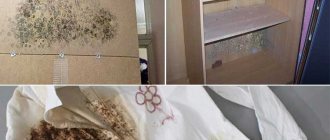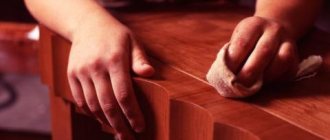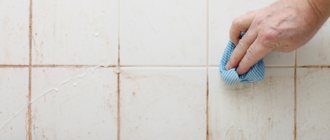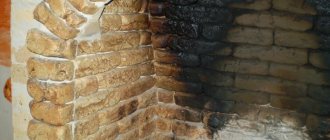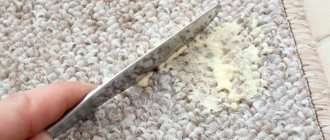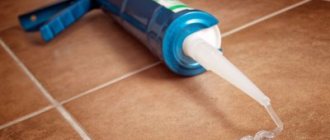Plastic windows are comfortable and aesthetically pleasing, but their main drawback is their inability to let air through. Because of this, condensation forms on surfaces and black mold develops. The spots will quickly grow in breadth and depth. Then it will be very difficult to remove. You don't need to call in a professional to deal with mold. There are effective ways to deal with this issue.
Causes of mold
The battle against mold will be unsuccessful if the cause of its occurrence is not found and eliminated. Typically, black spots on plastic windows are formed due to significant humidity and lack of access to fresh air.
There were many cracks in the old wooden windows, thanks to which the air moved. Because of the cracks, it was colder and drafty, but there was no significant humidity. After replacing wooden frames with PVC double-glazed windows, the situation changes dramatically. There are no longer any drafts, the heat remains completely in the room, but due to the lack of fresh air flow, humidity increases and positive conditions are created for fungal infection.
The surface of the plastic is completely sealed. It does not absorb condensation and does not evaporate moisture like wood. Therefore, all conditions are created for the rapid reproduction and spread of spores. Inept window installers often violate technology. This leads to the accumulation of moisture on the plastic structure and the formation of a breeding ground for colonies when the windows become moldy.
Important! It is not enough to just wash off the mold that has formed on plastic windows. When the cause is not eliminated, the problem will appear again very soon.
Combating an unfavorable environment
To eradicate the problem completely, it is necessary to destroy the environment in which the growth of harmful microorganisms occurs. A thorough analysis of the window, frame, slopes and cornices should be carried out. Seal all cracks and eliminate possible drafts. Treat all seams with sealant to prevent future moisture penetration. Insulate the opening, apply plaster, pre-treating it with special primers and anti-mold compounds.
Tools and preparations for work
To get rid of mold on slopes, you will need special preparations that are used to treat the surface. For this purpose use:
- solutions with antifungal action;
- detergents containing chlorine.
To protect the skin on your hands and respiratory organs from exposure to aggressive components, wear rubber gloves and a mask. If the fungus has eaten deeply, you have to dismantle the slope. This cannot be done without special tools. Therefore, additionally prepare:
- spatula, drill and chisel;
- heat-insulating material;
- screwdriver, tape measure or ruler;
- means for sealing seams and joints;
- new plastic panel;
- special glue for plastic, sharp knife.
Ammonia
Ammonia is very effective for removing mold on plastic windows and glass. The mixture is diluted in a one to one ratio and applied to the contaminated surface using a spray bottle. After two hours, wash off with a sponge. When working with ammonia, you should ensure that the room is well ventilated and wear gloves on your hands, since alcohol vapors can cause vomiting, coughing, sore throat and dizziness, and the substances contained in ammonia can harm the skin of your hands.
Surface cleaning
The material of the slopes where moldy spots have formed is of great importance. If plastic is used, the plank is disassembled and the wall underneath is completely disinfected. Plasterboard panels are replaced with others. The fungus has already managed to penetrate the pores of such material, so it will not be possible to completely remove the colony.
Use a stiff brush to get rid of mold and completely clean it from surfaces, frames and walls. Then you need to treat the wall and the double-glazed window with a chlorine-containing substance, first protecting your hands with gloves.
Antiseptic treatment
Products for antiseptic treatment are purchased ready-made at a hardware or hardware store. Typically, they use copper sulfate or chlorine as the active ingredient. There are several options for making your own disinfectant composition.
First option:
- 200 ml acetic acid concentration 70%;
- 200 ml boric acid;
- 1 liter of water.
Second option:
- 100 ml copper sulfate;
- 100 ml sodium fluoride;
- 1 liter of water.
Third option:
- 1 part bleach;
- 1 part copper sulfate;
- 5 parts water.
Important! Before processing, gloves are put on your hands. Then the prepared wall is treated with an antiseptic using a brush. After finishing work, be sure to ventilate the room.
Consolidate the result
To prevent reoccurrence of mold, waterproof the surface. The slope is covered with construction mastic, creating a moisture-proof barrier on the wall. It will last for several years.
Complex cases
A window sill that has old rust stains or marks from flower pots is unlikely to be cleaned using folk remedies.
You will need serious household chemicals, in particular Cosmofen 10. It is ideal for removing all types of dirt.
The product is quite toxic, so it is recommended to additionally use a respirator.
After completing the work, the room should be thoroughly ventilated.
Limescale deposits can be removed with Cillit Bang spray.
Spray the composition onto the windowsill, distribute evenly with a sponge and leave for 10 minutes, then rinse thoroughly.
If you were unable to prevent the appearance of stains from the primer, then to remove them you can use foam or alcohol to soften the stain, special scrapers or sponges with hard bristles.
SZOP will help remove not only primer and rust, but also cement and gypsum
Remember: it is easier to prevent contamination, because it is unlikely that it will be possible to get rid of it without effort.
Place napkins or plates under flower pots, securely close the window sill before repairs, and wipe off stains as soon as you notice them.
Removing mold without removing slopes
If mold has just begun to spread over the surface of the windows and its foci have not completely captured the slope, the fight against the fungus is carried out without removing the slope. In this case, you need to wash off the black spots and dry the surface well. It is then important to keep the humidity level under control and not allow it to exceed a critical value.
Mold washing
To clean ceramic tiles or plastic panels, industrial household chemicals with an antiseptic effect are used. Suitable products for cleaning and disinfecting plumbing fixtures, bleaches and stain removers with chlorine are suitable for this purpose: Vanish, Domestos, Belizna, Sanitol and others.
You can also get rid of black spots using folk remedies. The following compositions help well:
- Table vinegar with a concentration of 9%, undiluted, is sprayed directly onto the stain and left for 1 hour. Then wash off the contamination with clean water.
- Baking soda is mixed with water to form a thick paste. It is applied to the mold areas and hydrogen peroxide is sprayed on top. After the end of the chemical reaction, the remaining mass is removed with a damp cloth.
- Dissolve 4 tbsp. l. baking soda in 1 liter of water and wash the areas with fungus with this solution. After treatment, the composition is not washed off.
- Tea tree oil ether in the amount of 1 tsp. combine with the same amount of salt and dissolve in 1 glass of water. Use this product to wash moldy stains on the window. It is not necessary to wash off the composition.
- 100 ml of bleach and the same amount of copper sulfate are dissolved in 1 liter of water. Use this product to wash the window surfaces. To protect the respiratory system, wear a respirator while working, and protect your hands with rubber gloves.
Important! Aggressive compositions with chlorine and other components are used only after other means have been tried. They provide an excellent disinfectant effect, but can damage the top layer of the plastic coating.
To remove mold from slopes painted with water-based paint, it is not advisable to wash them. In this case, using a stiff brush, drying with hot air, and disinfecting with a quartz lamp will help get rid of mold on the windows.
Drying
Plastic windows, washed from mold on the slopes, are thoroughly dried using any available methods. To do this, wipe them dry and open the window wide. This will help any remaining moisture evaporate. The slopes painted with water-based emulsion and the plastic parts of the window are dried with hot air from a hairdryer.
Important! When using a hair dryer, do not direct the jet at the glass. If the temperature outside is low, sudden heating will cause the glass surface to burst.
Ventilation
To maintain the required level of humidity and ensure ventilation, arrange regular ventilation. According to doctors, it is useful to open windows every hour for a few minutes. But if this is not possible, ventilation is done in the morning and evening hours. It is advisable not to close the doors to the room so that air circulates in the room.
It is useful to prevent the formation of mold around plastic windows by constantly monitoring the optimal humidity level. In this case, a household hygrometer will help. This device should show a humidity value of 45-60%.
High-quality ventilation is especially important during cooking, so as not to think about what to do if there is mold on the slopes of plastic windows. Therefore, when cooking, use a hood. If there is no such device in the kitchen, open a window.
To prevent mold from forming, you should not hang wet laundry around the apartment to dry. It is also worth giving up a large number of indoor plants on windowsills. They increase the level of humidity in the air.
Curtains
The microclimate in the room and the level of humidity are greatly influenced by the material of the curtains on the windows. Curtains made of synthetics do not allow air to pass through well, so dampness stagnates in the space between the window glass and the tulle. For optimal circulation of air masses, it is recommended to hang curtains made of natural lightweight fabrics on the windows. If necessary, such material will absorb excess moisture. If it is not possible to change the curtains, frequent ventilation will help.
Odor absorbers
Such devices are a plastic box or ball filled with sorbent. They are usually used to remove unpleasant odors from inside the refrigerator or for shoes. The odor absorber will help reduce dampness to some extent if you place it on the windowsill. You can make something similar to an industrial device yourself. To do this, pour cat litter into a bag made of natural fabric and tie it tightly. It is better to use wood filler. Such a homemade sorbent absorber is regularly dried on a battery.
Using an ionizer or ozonizer
There is no need to buy these devices specifically, but if they are already in the house, they can be used to remove mold from plastic windows. Ozonizers clean the air in the room from mold spores, germs, dust mites and other harmful microorganisms. For convenience, it is recommended to use small models designed for refrigerators. They are placed on window sills and turned on at the highest power. After a few minutes the value is reduced.
Application of quartz lamp
This is another way to combat mold. Any quartz lamp is installed on the windowsill and turned on, directing the rays at the blackened spot. Irradiation lasts 30 minutes. During this time, animals, children, aquariums, and indoor flowers are removed from the room. The door to the room is tightly closed.
After half an hour, turn off the lamp and ventilate the room. The rays of a quartz lamp destroy mold. Therefore, all that remains is to clean the black marks from the wall with a stiff brush and thoroughly dry the area with a hairdryer.
Tea tree oil
Tea tree oil is an expensive remedy, but it is the most effective in getting rid of mold. Dilute 2 tablespoons of oil in 2 faceted glasses of water and fill a spray bottle with this mixture. Apply the composition to slopes affected by fungus and leave without rinsing. After 1-2 days, the mold will disappear, but the pungent smell of oil will disappear for another 3-4 days.
Mold Prevention
So that you don’t have to wonder how to deal with mold on the slopes of plastic windows, you need to follow simple rules. They will help you avoid trouble:
- The ventilation hole in the kitchen is left free. This room most often experiences high temperature and humidity, and closed ventilation prevents free air circulation.
- The condition of plastic windows is checked twice a year. If malfunctions or breakdowns are detected, they are eliminated independently or with the help of a specialist.
- To prevent the air humidity in the room from increasing, do not plant indoor plants in large quantities.
- To improve air circulation in the apartment space, interior doors are opened.
- The apartment is ventilated every day. It's good if the house has air conditioning.
- It is better to dry clothes on the balcony. If it is not possible to hang it outside, open the windows while drying.
- Regularly treat slopes and window sills with products containing chlorine.
Important! Do not allow condensation to settle on the windows. Its appearance causes the formation of mold. Therefore, when condensation appears, immediately inspect the windows and destroy mold if it is found.
How to properly wash plastic windows
Regardless of the chosen means and washing technique, when cleaning plastic windows, the following rules must be observed:
- Do not combine alcohol-containing cleaning agents with hot or warm water;
- Avoid using sharp objects to clean plastic surfaces;
- do not use chlorine and acetone-containing compounds, acids and solvents;
- do not use abrasive substances.
It is recommended to wash plastic windows, starting with double-glazed windows and ending with the frame and window sill. When choosing products, you should consider the type of stains that frequently appear. In addition, to clean a plastic window, you will need soft sponges, rags, paper towels and/or napkins.
Wash the double-glazed window so that there are no streaks
Plastic windows should be washed, starting with cleaning the sashes from dust, dirt and cobwebs. To do this, you can use dry rags and a vacuum cleaner. Next, wipe the glass with soapy water or water. After that:
- a cleaning gel or other product is added to the water (can be washed with either a store-bought or homemade solution) and the glass is wiped again from the inside;
- the upper, side, and then the lower sashes are washed from the inside and outside;
- using a telescopic mop, wipe the “solid” glass from the outside (you need to move from the far wall towards yourself);
- The glass is wiped with a dry cloth or paper towel.
During the cleaning process, you should frequently change the water and rinse the napkin (sponge). At the end of the procedure, you can go over the glass again with a dampened cloth without using cleaning agents or soapy water.
We clean the frame and window sill from various contaminants
A quick way to wash plastic slopes, frames and window sills is to apply one of the following products to areas of contamination:
- "Mister proper";
- gel "Domestos";
- cleansing cream "Mr. Muscle";
- gel "Comet".
Methods for removing rare types of contaminants (paint, polyurethane foam) are described above. It is recommended to wash greasy stains using dish soap or soap solution. These same products help get rid of the blackness that accumulates outside. In other cases you will need:
- vegetable oil or medical alcohol (remove traces of tape);
- half an onion (used to clean traces of flies);
- a mixture of ammonia and water (removes traces of unknown origin);
- rubbing alcohol (used to remove marker stains).
It is recommended to wash the plastic immediately after stains appear. Some substances are able to penetrate deep into the material, leaving behind indelible marks.
Remaking plastic slopes
If black mold appears on the windows and covers a large area of the panel, it cannot be removed using conventional means. In this case, a complete rework of the slope is required, since the main mass of fungus is usually hidden under it. To do this, remove the outer decorative corner with a chisel, pick up the side part with a spatula and, loosening it a little, remove it. If it is attached to polyurethane foam, use a sharp knife to cut it and remove the part. The remaining parts of the slopes are removed in the same way.
After removing the thermal insulation, inspect the seams. In this case, you can see that moisture penetrates the slope from the outside. Then you need to thoroughly seal the external interpanel joints. For residents living on the top floor, they cannot do without the help of climbers.
Consolidate the result
To prevent mold from appearing on the window sill and around the glass, it is necessary to waterproof it, eliminating the cause of fogging. After removing and dismantling the slopes, the builders' shortcomings will become visible. It is necessary to compensate for the lack of waterproofing material and fill all the voids between the wall and the window with polyurethane foam. Foam damaged by rot is also cut off, and the cracks are covered with putty or sealant.
Mastic is ideal for insulation, making the wall and slopes waterproof. Another significant advantage is durability. The applied waterproofing can last for several years and will not allow the surfaces to “bloom”.
Instead of mastic, you can use a primer that contains rubber. It will cover the wall with a thin film that will repel excess water and create a barrier to mold.
It is most convenient to apply such products using a silicone brush. Please note that the layer will not dry immediately - it will take several hours.
Ventilation and plumbing
To completely remove mold, it is important that the ventilation works well and there are no problems with the plumbing. To check the operation of the ventilation, bring a flame from a lighter or candle to its grille. If the tongue does not move, it means the ventilation is closed. In this case, they call a technician to clean the channels. If this is not the reason, then the installation of a special fan is required, which will promote air circulation in the room.
Special supply valves are installed on window units to improve ventilation. They provide a flow of fresh air, prevent windows from “sweating” and prevent the development of mold. To reduce humidity during cooking, install a hood above the stove.
Faulty plumbing is also a common cause of high humidity. Then all leaking taps and pipes are repaired. It is also worth considering the material from which the pipes are made. Condensation often settles on a metal surface, so it is better to replace such pipes with plastic.
The most effective way
We believe that this option is really effective and will help you with 90% of stains and stains. So, you will need:
- Baking soda
- 9% vinegar
- Cheap dish detergent
- Warm water
- Clean rag
- 1. Wet a rag in water and not completely wring it out.
- 2. We wipe the window sill without effort, just moisten it.
- 3. Next, straighten the cloth and pour it generously with vinegar, and add detergent on top of this.
- 4. Take baking soda and sprinkle it in a thin layer all over the windowsill.
- 5. Turn the rag over and begin to thoroughly wipe the surface with soda.
- 6. Foam forms on the windowsill and we leave it for 10-15 minutes.
- 7. Next, rinse the cloth and wipe the surface until all the foam is removed. Ready!
A similar method is shown in this video:
As reviews from many housewives show, this is the way to get rid of absolutely most stains, which is especially visible on white plastic window sills.
But there are a few more ways that we would like to mention.
